Why North American Airlines Have Been Slow to Embrace the Embraer E190 and E195

Despite the Embraer E190 and E195 enjoying widespread global success, their adoption in North America—particularly in the United States—has been notably limited compared to smaller regional jets like the Embraer E175. While airlines in Europe, Latin America, and Asia have embraced the E-Jet family for its efficiency and comfort on short- to medium-haul routes, U.S. carriers have been slower to follow suit.
The reasons lie in a mix of regulatory, operational, and economic factors: restrictive pilot union scope clauses that limit the size and weight of aircraft operated by regional partners, concerns over fleet commonality with existing narrowbody types, and evolving market dynamics that favor either smaller regional jets or larger mainline aircraft. Together, these constraints have kept the E190 and E195—especially the next-generation E2 variants—from reaching their full potential in the North American market.
The Airbus A220 offers greater range, passenger capacity, and fuel efficiency than the Embraer E190/E195-E2, but comes at a higher acquisition cost—making Embraer more attractive for short-haul, cost-sensitive operations.
For airlines operating in North America or Europe, choosing between the Airbus A220 and Embraer E190/E195-E2 depends on route structure, fleet strategy, and financial priorities. Both aircraft target the 100–150 seat market, but they diverge in performance and economics.

The Airbus A220, available in two variants (A220-100 and A220-300), is a clean-sheet design optimized for fuel efficiency and passenger comfort. It features a wider cabin, larger overhead bins, and quieter engines. The A220-300, in particular, has become popular with carriers like Delta, Air France, and JetBlue for its ability to serve both regional and transcontinental routes.
In contrast, the Embraer E190/E195-E2 series is an evolution of Embraer’s successful E-Jet family. The E2 variants offer improved fuel burn, quieter operations, and lower emissions compared to their predecessors. Airlines such as Porter Airlines, KLM Cityhopper, and Helvetic Airways have adopted the E195-E2 for short- to medium-haul routes.
Cost and Capacity
- Airbus A220-300: ~$91 million list price; seats 120–150 passengers
- Embraer E195-E2: ~$65 million list price; seats 100–132 passengers
- Embraer E190-E2: ~$60 million list price; seats 96–114 passengers
Range and Performance
- A220-300: Up to 3,450 nautical miles (6,390 km); ideal for longer regional or thin transatlantic routes
- E195-E2: Up to 2,600 nautical miles (4,815 km); best for short- to medium-haul
- Fuel Efficiency: A220 has a slight edge in fuel burn per seat-mile, especially on longer sectors
Operational Considerations
- Airbus A220:
- Better suited for mixed fleet operations with larger Airbus aircraft
- Offers more cargo space and longer range
- Higher acquisition and maintenance costs
- Embraer E2:
- Lower purchase price and operating costs
- Faster turnaround times and better suited for high-frequency regional routes
- Easier pilot transition for airlines already operating E-Jets
In summary, the Airbus A220 stands out as the ideal choice for airlines seeking a versatile aircraft that bridges regional and mainline operations while delivering a premium passenger experience. Its longer range, quieter cabin, and wider seats make it especially suited for longer thin routes where comfort and efficiency are equally important—appealing to both full-service and hybrid carriers. The A220’s advanced avionics and fuel efficiency also position it as a long-term fleet investment for airlines expanding into new markets or replacing aging narrowbodies.
By contrast, the Embraer E190/E195-E2 shines in short-haul, high-frequency regional operations where cost control, flexibility, and quick turnaround times are crucial. Its lower acquisition and operating costs, optimized capacity, and strong performance from shorter runways make it an ideal fit for regional carriers or mainline airlines serving secondary airports. In essence, while the A220 represents a strategic move toward expanding range and passenger comfort, the E2 series remains a champion of operational efficiency and regional network strength—two aircraft designed to meet very different, yet equally vital, segments of modern air travel.
Related News: https://airguide.info/?s=airbus+A220, https://airguide.info/?s=Embraer E190
Sources: AirGuide Business airguide.info, bing.com
